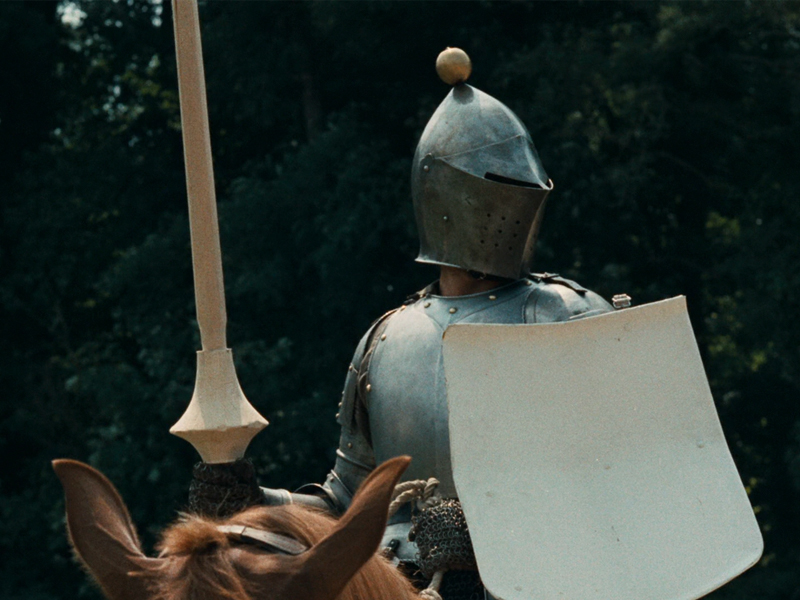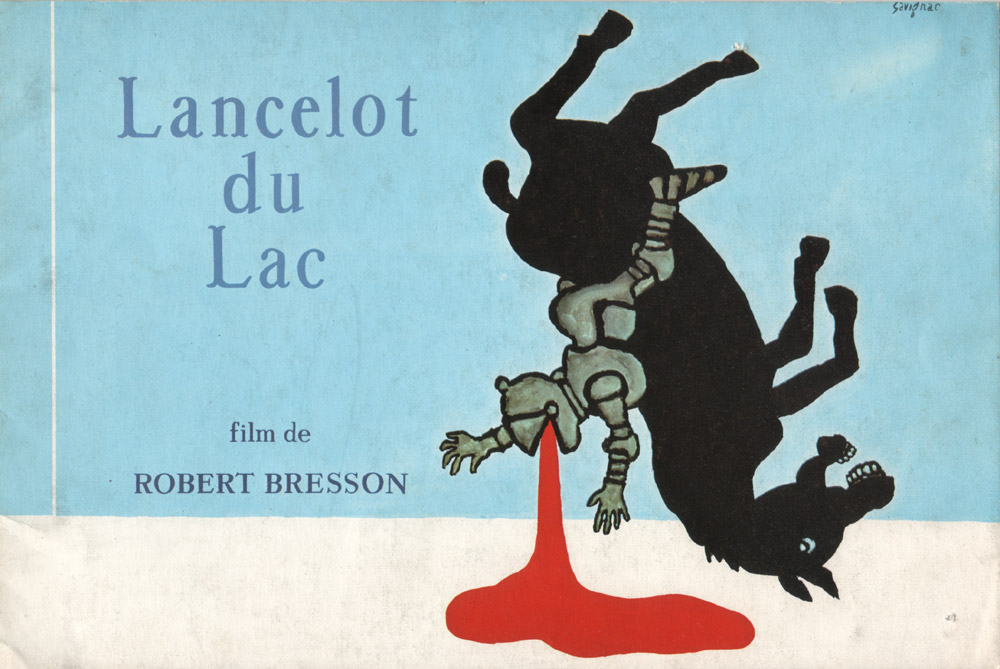
King Arthur learns about his wife’s, Queen Guinevere, affair with Lancelot, who at the same time remains loyal to the king, particularly after Arthur's traitorous nephew Mordred commits an attempt on his life.
“Stylistically, Lancelot is a quintessential Bressonian work. Typically, Bresson is known for the deliberately inexpressive quality of his style: the expressionless performance of his actors, the refusal to establish spaces and to emphaqize certain events with long shots, and the like. By doing a period piece, he was able to introduce armour into his panoply of devices for avoiding expressive performances. Not only do his actors deliver lines tonelessly, but often we see their faces or hands or feet sheathed in blank metal. And by equating the horses so completely with his human characters, he can show actions at one further remove by framing only the legs or bodies of the horses. Stylistic techniques similar to ones Bresson had worked with for three decaded were uused to perfection in this film.”
Kristin Thompson1
Interviewer: Wasn’t it hard to film with horses, knights in armor, and a lot of extras?
Robert Bresson: Contrary to what people believe, if you can work with very little, you’re able to work with a lot. Still, having greater means didn’t stop me from focusing on details, from suggesting instead of showing, and from giving much of the power over to sounds. The tournament scene is almost entirely edited for the ear . . . as are, in a way, all of the scenes.
You didn’t have any real problems with the horses?
They weren’t hired, but bought, and trained for a very long time. They were young and difficult. I had good knights.
From a pamphlet distributed at the film’s release in 19742
“Het dier Balthazar en de ridders uit het latere Lancelot du lac, onherkenbaar gekooid in hun rammelende harnas, zijn Bressons meest overtuigende ‘modellen’, gewoon omdat ze onbekwaam zijn om ons iets voor te houden.”
Michael Haneke3
Charles Bernstein: Whose work with film sound interests you?
Abigail Child: Godard definitely. In some of his latest work he lets the voice slip, and a man’s voice replaces a woman’s voice; and he’s playing really, many, many subversions. Also Bresson, his Lancelot du Lac, for instance, where we hear the horses coming for two minutes before they appear.
Charles Bernstein in conversation with Abigail Child4
“Another maddening art film that really impressed me. Bresson meets the Knights of the Round Table, sort of, since this film is told almost entirely in close-ups or medium shots of armour, helmets, boots, horses’ hooves, and very, very few human faces. In fact, although it seems like a cast of thousands, it is actually only a handful playing many different roles. Since you are introduced to a character from a rear view or by their footwear, Bresson could really save money by having one actor play twenty different parts. If ever there was an anti-star movie, this is it. Students of film budgets ought to watch this great screen economy at work and marvel at what the Screen Actors Guild might think.”
John Waters

- 1Kristin Thompson, “The Sheen of Armour, the Whinnies of Horses: Sparse Parametric Style in Lancelot du Lac,” in Robert Bresson, edited by James Quandt (Toronto: Cinematheque Ontario, 1998).
- 2“To Bring the Past into the Present,” in Bresson on Bresson. Interviews 1943-1983, edited by Mylène Bresson (New York: New York Review Books, 2016).
- 3Michael Haneke, “Terreur en utopie van de vorm. Verslaafd aan waarachtigheid: Robert Bressons Au hasard Balthazar,” vertaald door Marie Claes en Gerard-Jan Claes, Sabzian, 15 december 2013. Deze tekst verscheen origineel als “Schrecken und Utopie der Form - Süchtig nach Wahrhaftigkeit: Eine Kinoerzählung über Robert Bressons “Au Hasard Balthazar” in Frankfurter Allgemeine: Zeitung für Deutschland, 6-7 Januar 1995, Nr. 5-6.
- 4Charles Bernstein, “Time Corners.A Conversation with Abigail Child,” XDREAM 1, no. 1 (1986). Republished on Sabzian, with an introduction by Veva Leye and Jan Op de Beeck, 4 September 2019.

